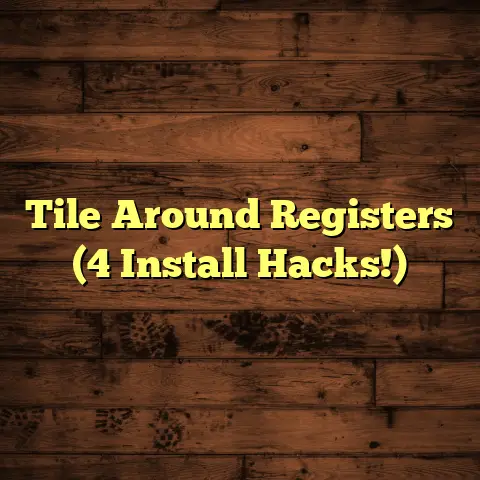Floor Grout Sealing: Needed? (3 Sealant Secrets!)
Have you ever wished there was a magic trick to keeping your tiled floors looking brand new? Free from the stains and grime that seem to appear no matter how much you clean?
Well, grout sealing might just be that trick! As a flooring contractor with years of experience, I’ve seen firsthand the difference it can make.
Let’s dive into whether grout sealing is really needed, and I’ll share some secrets to get the best results.
1. Understanding Grout and Its Importance
Okay, let’s start with the basics: What exactly is grout?
Simply put, it’s the material that fills the gaps between your tiles.
Think of it as the glue that holds your tiled masterpiece together. It’s not just there for looks; it plays a crucial role!
There are different types of grout. Let’s look at some of the most common:
-
Sanded Grout: This type has sand added to the mix. It’s best for wider grout lines (1/8 inch or more) because the sand helps prevent cracking.
-
Unsanded Grout: Without sand, this is smoother and ideal for narrow grout lines (less than 1/8 inch). It’s often used on walls to avoid scratching delicate tile surfaces.
-
Epoxy Grout: This is a powerhouse! It’s made from epoxy resins and a hardener, making it extremely durable, stain-resistant, and waterproof. It’s a bit pricier, but worth it for high-traffic areas or places prone to moisture.
-
Cement-Based Grout: The most common and affordable type. It’s made from a mixture of cement, water, and sometimes polymers for added flexibility. It requires sealing to protect it from stains and water damage.
Grout is important for a few key reasons:
-
Structural Integrity: It binds the tiles together, creating a strong, stable surface. Without grout, your tiles would be loose and prone to cracking.
-
Moisture Prevention: Grout helps prevent water from seeping under the tiles, which can lead to mold growth, structural damage, and costly repairs.
-
Aesthetics: It provides a clean, finished look to your tiled surface.
Now, here’s the thing: Unsealed grout is like a sponge. It’s porous, meaning it has tiny holes that allow liquids and dirt to penetrate.
This leads to some common problems:
-
Staining: Spills like coffee, wine, or even just dirty water can easily stain unsealed grout.
-
Discoloration: Over time, unsealed grout can become discolored from dirt and grime buildup.
-
Mold Growth: Moisture trapped in the grout creates a breeding ground for mold and mildew, which can be unsightly and even harmful to your health. According to the CDC, molds can cause nasal stuffiness, throat irritation, coughing or wheezing, eye irritation, or, in some cases, skin irritation. Source: CDC
I’ve seen countless floors ruined by neglecting grout sealing. It’s much easier (and cheaper!) to prevent these problems than to fix them later.
2. The Need for Grout Sealing
So, why should you even consider sealing your grout?
Let’s get real: Life happens. Spills happen. Foot traffic happens. And your grout takes the brunt of it all.
Here’s why grout sealing is a smart move:
-
Enhanced Durability and Longevity: Sealing creates a protective barrier that helps prevent wear and tear. It’s like giving your grout a shield against the daily grind.
-
Easier Maintenance and Cleaning: Sealed grout is much easier to clean. The sealant prevents dirt and grime from penetrating, so you can simply wipe away spills with a damp cloth. No more scrubbing for hours!
-
Prevention of Stains and Discoloration: This is a big one! Sealing keeps those nasty stains at bay, so your grout stays looking fresh and clean.
-
Protection Against Mold and Mildew: By preventing moisture from penetrating, sealing helps inhibit the growth of mold and mildew. This is especially important in bathrooms and kitchens.
Let’s look at some numbers.
A study by the National Tile Contractors Association (NTCA) found that properly sealed grout can extend the life of a tiled floor by up to 50%.
That’s a significant saving in the long run!
I’ve personally seen cases where homeowners who sealed their grout had floors that looked great after 10+ years, while those who didn’t had to replace their floors after only 5 years due to staining and damage.
Now, there are some common misconceptions about grout sealing that I want to address:
-
“All Grout is Waterproof”: This is simply not true! While some types of grout, like epoxy grout, are inherently waterproof, most cement-based grouts are porous and require sealing.
-
“Sealing is a One-Time Thing”: Nope! Grout sealant wears down over time, especially in high-traffic areas. You’ll need to reapply it periodically to maintain its effectiveness.
-
“Sealing is Too Expensive”: While there is an initial cost, it’s far less expensive than replacing your entire tiled floor due to grout damage. Plus, you can save money by doing it yourself!
Think of it this way: Grout sealing is like investing in a good coat of paint for your walls. It protects the underlying surface, enhances its appearance, and extends its lifespan.
3. Sealant Secrets: Types and Application Techniques
Alright, let’s get down to the nitty-gritty: What kind of sealant should you use, and how do you apply it?
There are three main types of sealants available:
-
Penetrating Sealers: These sealants soak into the grout, creating a barrier from within. They don’t change the appearance of the grout and are ideal for natural stone tiles.
- Advantages: Invisible protection, allows grout to breathe, long-lasting.
- Disadvantages: May not provide the same level of stain resistance as topical sealers.
-
Topical Sealers: These sealants form a coating on top of the grout. They offer excellent stain resistance and can even enhance the color of your grout.
- Advantages: Excellent stain resistance, can enhance grout color, easy to apply.
- Disadvantages: Can change the appearance of the grout, may wear down faster than penetrating sealers.
-
Epoxy Sealers: These are the heavy-duty sealants. They’re extremely durable, stain-resistant, and waterproof. They’re a great choice for high-traffic areas or places prone to moisture.
- Advantages: Extremely durable, stain-resistant, and waterproof.
- Disadvantages: Can be difficult to apply, may change the appearance of the grout, more expensive than other types of sealants.
Now, let’s talk about how to apply grout sealant like a pro. Here’s a step-by-step guide:
-
Preparation is Key: Start by thoroughly cleaning your grout. Use a grout cleaner and a scrub brush to remove any dirt, grime, or stains. Rinse well with clean water.
-
Let it Dry: Make sure the grout is completely dry before applying the sealant. This may take several hours or even overnight.
-
Choose Your Weapon: You can apply sealant with a brush, a spray bottle, or a roller. A small brush is best for precise application, while a spray bottle or roller is good for larger areas.
-
Apply Evenly: Apply the sealant in a thin, even layer. Avoid applying too much, as this can cause it to pool and create a sticky residue.
-
Wipe Away Excess: After a few minutes, use a clean cloth to wipe away any excess sealant from the tile surface.
-
Let it Cure: Allow the sealant to dry and cure according to the manufacturer’s instructions. This may take 24-72 hours.
Here are some tips to ensure the best results:
-
Read the Instructions: Always read and follow the manufacturer’s instructions for the sealant you’re using.
-
Test in an Inconspicuous Area: Before applying sealant to the entire floor, test it in a small, hidden area to make sure you like the results.
-
Ideal Conditions: The ideal humidity and temperature conditions for sealing are typically between 60-80°F and 50-70% humidity.
-
Ventilation: Make sure the area is well-ventilated while you’re applying sealant.
I’ve learned a few tricks over the years. One is to use a toothbrush for applying sealant in tight corners or around fixtures.
Another is to use a grout saw to remove any loose or crumbling grout before sealing. This will ensure a better bond and a longer-lasting result.
4. Maintenance Tips for Sealed Grout
You’ve sealed your grout, now what?
Maintaining sealed grout is actually pretty easy. Here are some tips to keep it looking fresh and clean:
-
Regular Cleaning: Clean your tiled floors regularly with a mild detergent and water. Avoid using harsh chemicals or abrasive cleaners, as these can damage the sealant.
-
Use Neutral Cleaners: Stick to pH-neutral cleaners specifically designed for tile and grout.
-
Avoid Abrasives: Steer clear of scouring pads, steel wool, or anything that could scratch the sealant.
-
Wipe Up Spills: Wipe up spills immediately to prevent staining.
-
Use Mats and Rugs: Place mats and rugs in high-traffic areas to protect the grout from dirt and wear.
-
Reapply Sealant: Depending on the type of sealant you used and the amount of traffic your floors get, you’ll need to reapply sealant every 1-2 years.
How do you know when it’s time to reseal?
-
Water Test: Pour a small amount of water on the grout. If it beads up, the sealant is still working. If it soaks in, it’s time to reseal.
-
Visual Inspection: Look for signs of wear and tear, such as discoloration, staining, or crumbling grout.
For minor repairs or touch-ups, you can use a grout pen to fill in small cracks or chips.
You can also mix a small amount of grout with water to create a paste and use it to repair larger areas.
I’ve found that a little bit of prevention goes a long way. By following these maintenance tips, you can keep your sealed grout looking great for years to come.
Conclusion
So, is floor grout sealing really needed?
In my professional opinion, absolutely!
While it may seem like an extra step, the long-term benefits for maintaining beautiful and hygienic floors are well worth it.
Sealing your grout protects it from stains, discoloration, and mold growth. It also makes it easier to clean and extends the life of your tiled floors.
Sure, it involves an initial investment of time and resources.
But think of it as an investment in the longevity and beauty of your home.
So, take a look at your own flooring. Is your grout looking a little worse for wear?
Could it use a little extra protection?
Maybe it’s time to consider grout sealing.
After all, a little bit of effort can go a long way in keeping your floors looking their best for years to come!
What are your thoughts on grout sealing? Have you tried it before?





